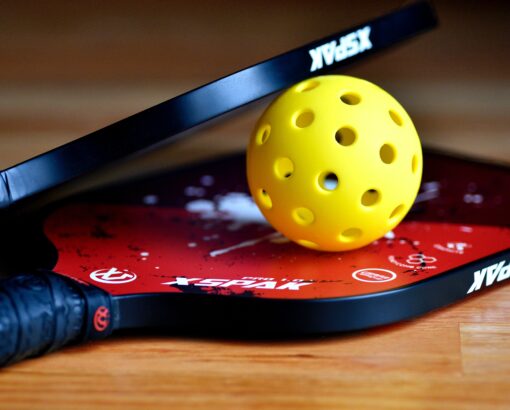
October was a big month for the sport of Pickleball: October 10th marked World Pickleball Day and two of the world’s biggest athletic superstars, Tom Brady and LeBron James, purchased Major League Pickleball franchises. The exciting developments in the pickleball arena mark just some of the latest highlights in what has been a transformational past few years for the sport.
The hobby that combines tennis, ping pong, and badminton has always been popular among the senior demographic but it has experienced a seismic shift as it is the most popular growing sport. Namely, pickleball currently attracts approximately 4.8 million players nationwide and is projected to attract an estimated 40 million players globally by the year 2030.
The biggest reason for the gravitation toward pickleball in recent years is indubitably the pandemic as it became an easy sport for people to pick up while in isolation. Pickleball mania has continued to takeover every region of the nation, both indoor and outdoor, and is not stopping anytime soon.
So, even though some communities have already had pickleball courts on their premises, especially the 55-and-better ones, many condominium associations/HOAs will soon be in the market for courts (if they do not have them already). Even though many may still have tons of questions about the sport, here are some starting points that boards and property managers should look out for from a legal perspective before (and after) installing pickleball courts:
Authorization to Build Pickleball Courts: Even though the costs to play pickleball are relatively low, the costs of building a pickleball court are cumbersome. And that is the case whether you plan to build a state-of-the-art indoor facility up in New England or renovating on a grassy field in Florida (although the latter will likely be less expensive). Regardless, the expenses required to overhaul the common areas and create a pickleball court would likely constitute a material alteration (FL) or improvement (MA). On the other hand, simply changing a tennis court to a pickleball court may be more in the gray area when it comes to the alteration/improvement definition. Cases such as Sterling Village Condominium, Inc. v. Breitenbach in Florida and Bonderman v. Touraj Naghieh in Massachusetts provide some insight on defining alteration and improvement, respectively.
Thus, it is important to check your governing documents to determine what constitutes a material alteration/improvement, look at the specific facts of your community, and identify what is needed vote-wise to approve this type of change to the common area. Governing documents might impose conditions such as requirements for votes of the unit owners to approve alterations/improvements.
For example, the Florida Condominium Act does not specifically define “material alteration” but F.S. 718.113(2)(a) specifies that no material alteration can take place to the common elements or the association’s real property unless it complies with the declaration or amendments thereto. F.S. 718.113(2)(a) goes on to state that if the declaration is silent as to the procedure for approval of a material alteration, then at least 75% of the total voting interests of the association must approve the material alterations before they commence.
For another similar and more nuanced illustration, the Massachusetts Condominium Act does not contain a definition of “improvements” but Mass. Ann. Laws 183A, s. 18 controls when an improvement can be made to the common areas of the condominium. The section provides that when 50-75% of the unit owners authorize an improvement, the cost of the improvement is borne solely by those unit owners voting in favor of the improvement, but if in excess of the 75% of the unit owners authorize an improvement, the costs of the improvement are treated as a common expense payable by all unit owners.
As such, this is not a Field of Dreams situation where ‘if you build it, they will come,’ but rather a ‘if your governing documents allow, and the procedure passes, you can build it… and then they will come.’ Not quite the same ring to it. Either way, it may be fruitful to check your governing documents. To take it a step further and if you are adamant about adding a pickleball court, it might be helpful to make sure you are getting enough votes. Electronic voting platforms such as GetQuorum are simplifying voting and removing any potential issues with voting across condominiums.
Construction of a Pickleball Court: Now that you have the right to build a pickleball court, you will need to build it. As many condominium and HOAs have been dealing with construction defects and design issues in the past few years, you will want to hire someone that is capable of building a proper court and can ensure the surfaces are up to code. However, you also don’t want to end up in a pickle by expending too much of the association’s funds to build the court. The ideal situation for building the court would involve retaining trustworthy contractors at an affordable rate, while also keeping the construction site safe and guarded from the community.
Proper Signage at the Court: With the court up and running, you will want to avoid liability by ensuring the court is fluidly operated. As the masses are rushing to find pickleball courts, it is good practice to have a capacity limit and that the sport is being played as it should be (i.e. proper equipment and no more than four people on the court at a time). A security guard on site may be able to assist with the flow of people in and out of the facilities, similar to how condominium guards may need to be more vigilant in January at the community’s gym. Generally, the pickleball courts should have clearly marked and unobstructed entry/exits, as well as clear and conspicuous signs regarding rules and regulations and hours of operation. It could also be good practice to implement an assumption of risk waiver and have residents and guests sign prior to play.
As it pertains to both construction of the pickleball courts and actual gameplay, there is the potential for injuries and exposure to liability. To reduce liability to your association due to play at the pickleball courts – and the possibility of ending up in the not-so-fun legal court – it would be shrewd to look into insurance options.
What’s the Racket – Noise Complaints: Unfortunately, pickleball is a noisy game and the noise can easily pickup as more ‘competitive’ players pick it up. And if the courts are not patrolled appropriately, associations could open themselves up to nuisance complaints. Prior to building the courts, the community should ensure the court is setup in a good location (i.e. away from units). If the court is already built but crowds are gathering and disruptive noises are going on all day long, then the associations could be required to take remedial actions, such as moving the pickleball courts or establishing restrictions on the activity. Setting up appropriate hours of operation and limiting the number of players at a time may assist with noise issues.
Have Fun… This last part is not necessarily legal guidance but can help to avoid unnecessary disputes with your neighbors. Keep in mind, sports are supposed to bring people together and can serve as a source of camaraderie rather than a point of built up contention. Communities will not agree on everything – allow a close play in pickleball to help unite your community rather than make issues more tense.

